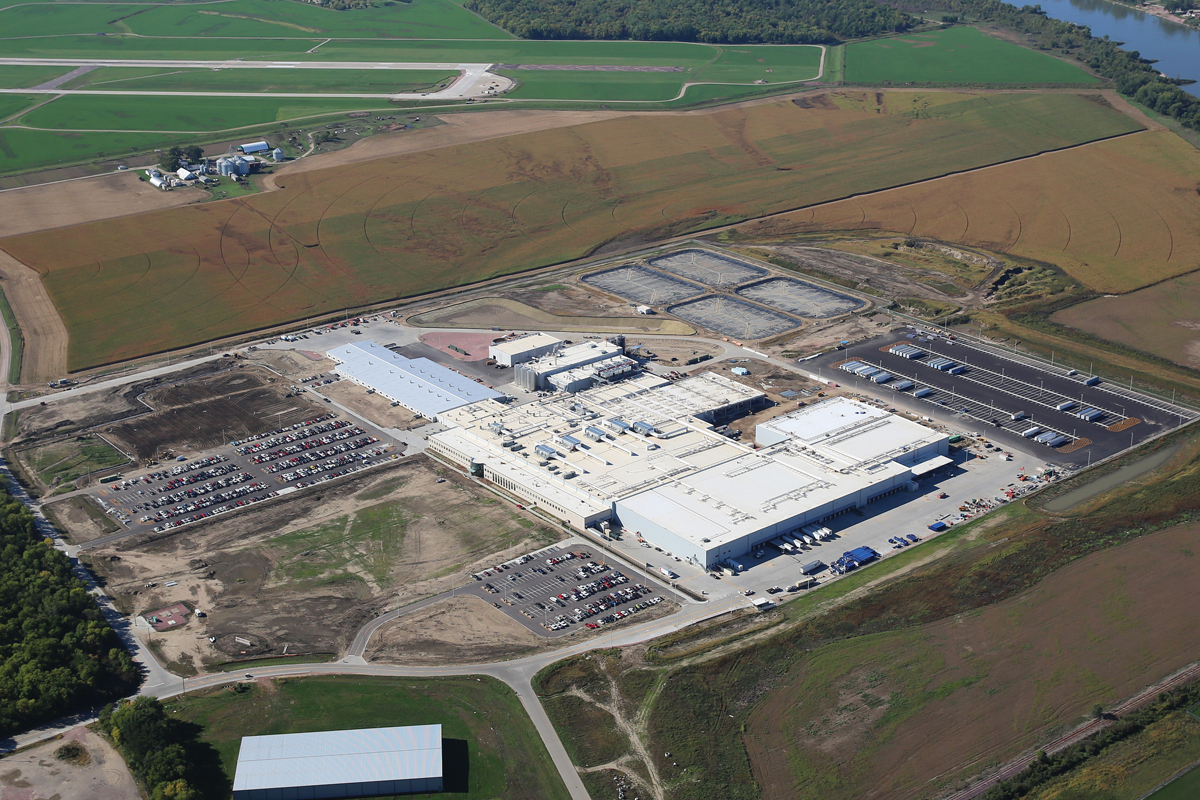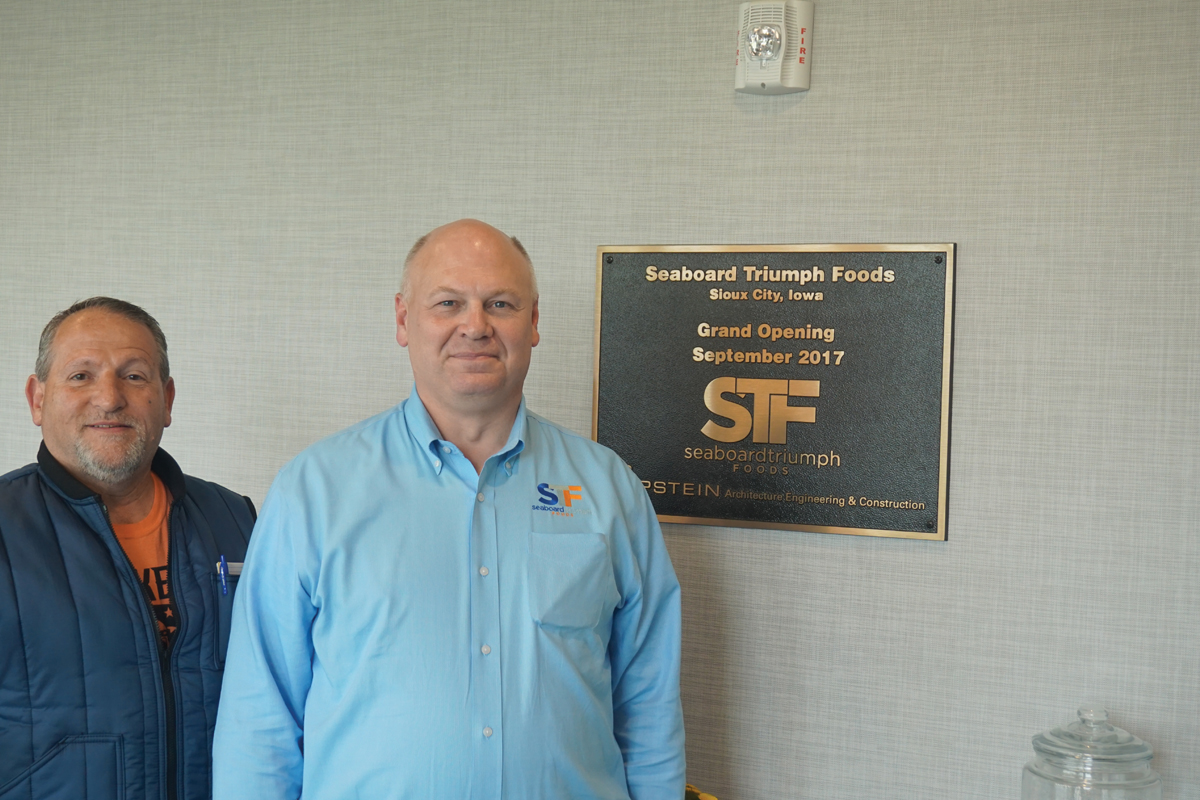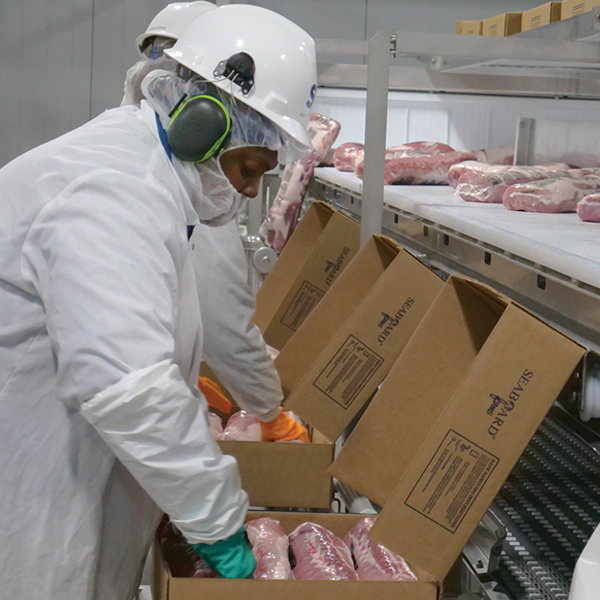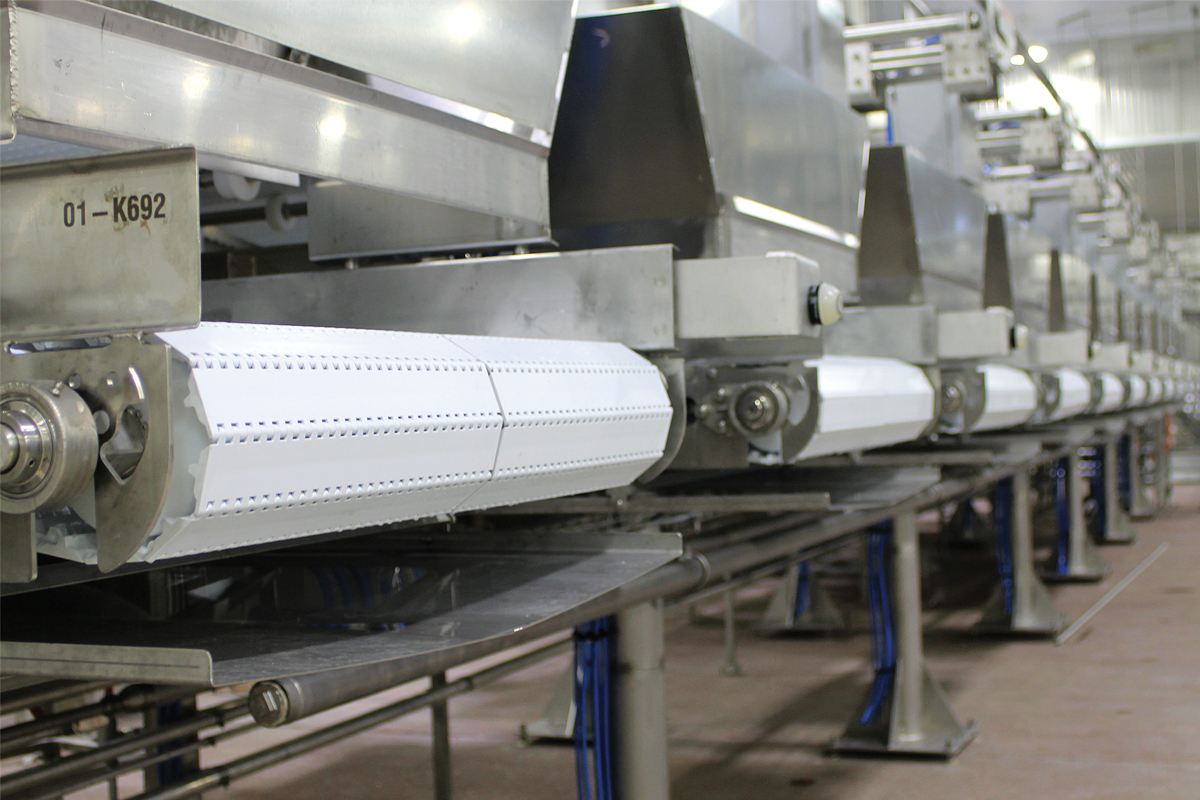It was about three years ago when Mark Porter sat down with Mark Campbell and Terry Holton to discuss a golden opportunity to lead a Herculean project that would become the STF (Seaboard Triumph Foods) plant in Sioux City, Iowa. Campbell, CEO with Triumph Foods, and Holton, then-president and CEO of Seaboard Foods, discussed how the prospect of leading the massive construction and the start-up of the plant was nothing short of a dream job for the right person. They agreed it wouldn’t be without challenges but would be well-supported by two solid pork powerhouses with a history of succeeding with partnerships in the past. “I was employee No. 1,” Porter recalls of his taking the job as chief operations officer that began in early 2016. At that time, it was almost unfathomable that the blank slate that was 259 acres of land adjacent to a regional airport in Sioux City, Iowa, would be home to a pork plant spanning nearly 1 million sq. ft. and slaughtering more than 10,000 hogs per day in about two years.
STF wasn’t alone in the pork race, with a flurry of five new pork plants sprouting over the past two years as other processors recognized the opportunities of domestic and international demand for pork and had put millions of dollars where their mouths were to capitalize on it. Other new pork plants that had recently come online included Moon Ridge Pork’s plant in Missouri, Comfrey Prime Pork in Minnesota, Clemens Food Group’s facility in Michigan and Prestage Farms’ soon-to-be open new plant in Eagle Grove, Iowa.
Triumphant partners
The sprawling plant in Sioux City wasn’t the first collaboration between Seaboard and Triumph, but this was easily the largest project to date.
The joint venture is part of a longstanding business relationship between Seaboard Foods in Merriam, Kansas, and Triumph Foods, based in St. Joseph, Missouri. Seaboard is the second-largest hog producer and the fourth-largest processor of pork in the US. Triumph Foods is a producer-owned, pork production and processing company that was established in 2003. Christensen Farms is the largest shareholder in Triumph Foods. Triumph’s first pork-processing plant, which has grown to 750,000 sq. ft. and was initially a $135 million investment, has been in operation in St. Joseph, since 2006. It was developed with plenty of input from Seaboard, which at that time operated a similarly designed facility in Guymon, Oklahoma, where operations continue today.
Since day one, Seaboard Foods, a wholly owned subsidiary of Seaboard Corp. in Merriam, has marketed and sold fresh pork processed at the Triumph plant in addition to fresh pork from its Guymon facility. The same arrangement is part of the partnership at STF. Products manufactured at STF are sold to domestic markets under the Prairie Fresh Pork brand and to international markets under the Seaboard Farms and St. Joe Pork brands.
In between the construction of the Triumph plant and the STF facility, the two companies partnered on another venture. In 2005, Seaboard acquired Daily’s Premium Meats, including its two bacon-processing plants in Montana and Utah. Triumph Foods purchased a 50 percent interest in Daily’s in 2014 and the two companies agreed to build a new Daily’s bacon plant within eyeshot of the Triumph plant in St. Joseph. That plant, spanning about 115,000 sq. ft., was a combined investment of $54 million and began operating in 2016.

Eyes on Iowa
The decision to build the massive plant in Sioux City was multi-fold. According to Porter, the 259-acre plot of land in northwest Iowa’s Bridgeport West Industrial Park was all about accessibility to market hogs, the availability of a food-industry familiar workforce in the region, a supportive local and state economic development team, not to mention, “this was a shovel-ready site.” Ground was broken at the site in 2015. Porter points out anecdotally that the site of the new plant sits just across the Missouri River from what represents a significant part of the region’s history, the Sioux City Stockyards. The plant is also located just north of the Sioux Gateway Airport along the Missouri River.
At almost 1 million sq. ft. – 942,000 sq. ft. to be exact – the plant occupies about 22 acres with a price tag of $335 million. Its design is somewhat of an evolution of Seaboard’s Guymon plant, built about 20 years ago, and Triumph’s plant in Missouri, built about 10 years later.
Looking back, Porter says having been on the ground level of the project from day one and living through the construction phase and up to the point where the first hogs were processed wasn’t without its challenges. “There were many, many sleepless nights getting through the construction phase,” he says. The two-year process included getting the technical details worked out and keeping everything coordinated and on schedule, which was a daily, logistical juggling act lasting about two years.
Porter remembers well his first day as the only STF employee on Feb. 1, 2016. “By the end of the 2016 calendar year there were 13 of us. By the end of 2017 there were 1,200 of us. And now there are almost 1,600 of us,” he says of the employee numbers as of June, and that number continues to grow as the company looks toward expanding production to a second shift this fall.
Hire and hire
To lure the number of workers needed to fill thousands of positions, STF had to reach a broader audience to promote its advantages as an employer in a region where many other meat and poultry processors compete for their share of the labor pool. Human resource officials couldn’t rely on “help wanted” ads in the classified section of area newspapers and posting “now hiring” signs around town. According to Porter, referrals from other employees was one of the top sources for recruiting new workers, but social media and the company’s website have proven to be the most effective tools. Based on feedback from nearly 4,000 recent applicants, about 35 percent of them found out about STF’s job opportunities from postings on its website, on the company’s Facebook page or from Indeed. Ads on radio broadcasts or those published in newspapers combined only represented about 12 percent of applicants.
The hiring piece of the equation proved to be a bigger challenge than most could ever have imagined. “We’d like to already be killing and cutting on second shift,” Porter says, but that delay has since been stemmed and the company has targeted mid-October to begin second-shift pork processing. After a ramp-up period to reach full second-shift capacity, the plant will employ more than 2,000 employees. The additional shift will eventually push the plant’s daily production to 21,000 head. Preparations have been in the works since May, as operations officials train new workers, and HR officials continue hiring. Limited second-shift operations have been running ahead of the October goal. The plant will ultimately process a minimum of 4 million lbs. of pork each day and slaughter 6 million hogs per year.

Flipping the switch
Commercial operations at STF began Sept. 5, 2017. Besides a larger footprint on a much larger parcel of land compared to Triumph’s or Seaboard’s plants, some of the unique design features at STF include seven unloading docks, a livestock holding capacity of 9,500 head, a carcass bay holding capacity of 24,552 head and a storage area able to hold 18,000 pallets. While these numbers all exceed those at the plants in Guymon and St. Joseph, the plant also reflects other improvements on previous designs. LED lighting throughout the facility, including the holding areas and throughout the processing areas of the plant, not only provides a white-light brightness that allows workers to perform their duties more safely, but also eliminates shadows to the benefit of animals and humans.
Animal welfare features include stamped concrete floors in the holding areas, non-slip and non-glare flooring in live animal handling spaces in addition to the absence of 90-degree corners in driving chutes. Holding areas for the livestock are also equipped with low-to-the-ground water sprinkler systems and fans to keep the hogs cool and an exhaust system designed to keep fresh air circulating. The animal handling system and animal welfare program at the plant has been inspected and approved by animal welfare expert, Temple Grandin, Ph.D., who also aided in the design of the stockyards during construction. Lauren Davis is the barn manager and animal welfare manager at STF. She studied under Grandin at Colorado State Univ.
For a given day of production, the first shipment of hogs is unloaded between 11 p.m. and midnight, which begins a sequence of about four trucks being received at the plant every 30 minutes until about 10:00 each morning. As of June, a typical day would include delivery of between 9,500 and 10,500 head to the plant, adjusting shipments to accommodate the plant’s operations.
“Yesterday was our new high watermark at 10,286,” Porter says. Approximately 30 percent of the market hogs processed at the Sioux City plant will be sourced from regional producers once second-shift operations begin. The remaining hogs are supplied by Triumph’s producer-owners and Seaboard Foods’ producers. The director of hog procurement works with the plant’s scheduler to coordinate shipments of hogs that are sourced from outside the company’s network of producer-owners.
Daily purchases, shipments and scheduling of hogs delivered to the plant are handled by the procurement team, including Dave Cary, vice president of hog procurement, and Shawn Smith, manager of scheduling and price reporting.
Pork from the STF plant is shipped not only throughout the US, but all over the world. Products are exported to Japan, Korea, China, Mexico, Guatemala, Ecuador, Canada and beyond.
Domestically, STF supplies many pork further processors, foodservice and retail customers with a product mix of boxed fresh pork and combos that is similar to the Triumph and Seaboard plants.

Streamlining processes
On the harvest floor at STF, animals are rendered insensible using two Butina CO2-based stunning systems. According to Stan Scott, general plant manager, there is always one chamber loading, one unloading and one that is in transition. The other four are in the pit administering the stun. The benefits of using CO2 stunning technology are obvious, he says, including, “less broken backs, less blood splash and better-quality product coming out.”
After stunning, hogs are hung on the overhead rail using a traceable trolley identification and sorting system. Following the bleeding process, hair removal begins, using a scalding tub and then a system of four de-hairing tumblers. Finally, carcasses continue through several hair-singeing machines and water polishers followed by manual shaving.
Automation is abundant at the plant, eliminating what are labor intensive processes at traditional operations. A system of robotic neck clippers, belly openers and back splitters all operate with efficient precision, using visioning systems to detect variations in carcasses and replacing seven line workers.

Carcass chilling and storage at the plant is extensive. After a hot weight scale reading and final wash, carcasses move through the snap chill room, where they are blasted with minus 35°F air for 110 minutes, which forms a frigid crust on the surface and preserves moisture. From there, carcasses move to equilibrium bays where they rest at 28°F for 18-24 hours to reduce internal temperatures.
Other cold storage areas include two freezer storage rooms, five blast-cell chambers, a fresh combo storage area and a fresh storage room. The shipping area is maintained at 40°F and contains 28 loading docks with enough space to stage an entire truck load prior to a truck’s arrival.
Automation is also part of the sanitary design of the plant, including automated wash systems that deliver up to 3,000 gallons per minute of wash-down flow to equipment and conveyor systems. A state-of-the-art wastewater treatment system is also designed into the plant to maximize waste recovery while complying with environmental requirements. The wastewater treatment facility includes four anaerobic lagoons that produce methane gas which is captured and reused to produce steam.
The processing bells and whistles don’t stop at the kill floor. STF’s cut floor features ergonomically designed work stations, a drop ceiling to prevent condensation and the entire processing area is bathed in LED light. Automated belly trimmers and loin-pulling equipment eliminate at least two areas where several workers would otherwise be positioned. The stainless-steel walled cut floor also houses the plant’s trim blend room, a space for a future value-added room and additional automated technology designed to sort and classify product by weight or spec. Spiraling down from the ceiling behind the walled area from the cut-floor are stainless steel slides where the second-floor box shop supplies boxes for packaging and shipping. Another logistics feature is the plant’s storage capacity of 18,000 pallets.
Supplier reliance
With operations up and running, STF looks to its equipment and technology providers to play a supportive role moving forward. Supplier partners were essential during the process of designing, building and starting up operations at STF. “Now we’re in the process of refining, tweaking and chasing down the highest degree of reliability and yield,” Porter says, as operations are more reliant on electronic monitoring and data collection than in many dated plants.
“If our network goes down, it becomes very difficult to successfully process meat,” he says. For now, the efficient production of high-quality and safe fresh pork while keeping the thousands of STF workers safe are priorities.
“There is some discussion about what is next,” Porter says. “Do we do something the other two don’t; do we pick up some new capability that enhances the overall Seaboard, Triumph and STF offering?” he says, shrugging.
The two-year whirlwind of breaking ground to today, Porter says, was a mammoth undertaking that required a village of dedicated professionals from Seaboard, Triumph and STF. “We’ve covered an incredible amount of ground in a very short window of time and performing at a very high level.”
“Reaching the point that we were finally able to start killing and cutting pigs was pretty amazing; pretty exciting,” Porter says.
He is reminded daily of the long path his team navigated to get to this point “We’ve got an incredible team out there getting it done.”
Thinking back again to that 2015 meeting with Campbell and Holton, Porter affirms that the golden opportunity they proposed was indeed just that.
“I’d say it lived up to that billing: Dream job.”

